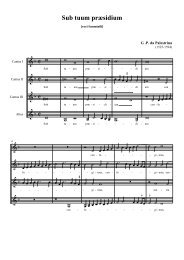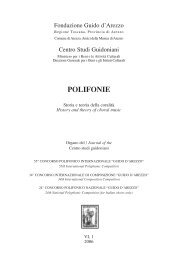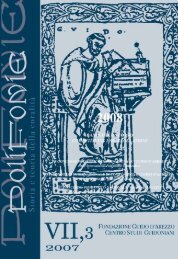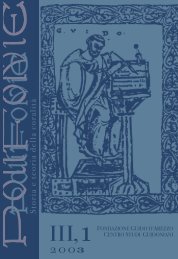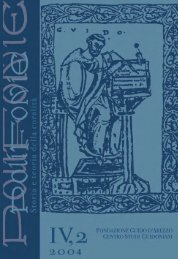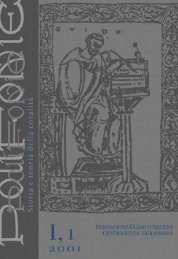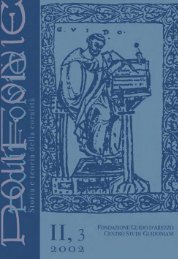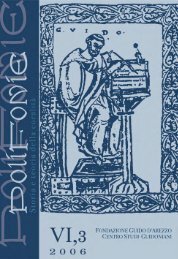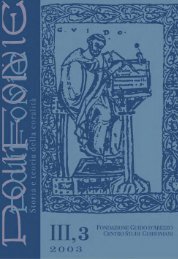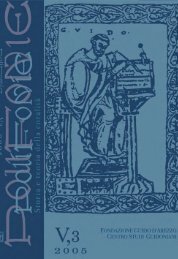Riviste Polifonie/119_2005 n 2.pdf - Fondazione Guido d'Arezzo
Riviste Polifonie/119_2005 n 2.pdf - Fondazione Guido d'Arezzo
Riviste Polifonie/119_2005 n 2.pdf - Fondazione Guido d'Arezzo
You also want an ePaper? Increase the reach of your titles
YUMPU automatically turns print PDFs into web optimized ePapers that Google loves.
MARCO GOZZI<br />
havrò per grandissimo favor poter haver il remanente del canto fermo poi ch’è<br />
così ben purgato da barbarismi et da i mali suoni et se l’Altezza vostra si contentarà<br />
si mandaranno in stampa con il graduale che nostro signor mi ha comquin<br />
Graduale ipsum praestantibus et pulcherrimis<br />
imaginibus, suis locis positis, in lucem<br />
prodiret. Quampropter hunc meum laborem<br />
vultus hilaritate, laetaque fronte accipietis,<br />
atque illamet religione, quae cantibus ecclesiasticis<br />
et spiritualibus debetur, amplectamini;<br />
me ultro offerens pro usu et commodo Ecclesiae<br />
Sanctae, in aliis et similibus operibus perseveraturum.<br />
Valete.<br />
wakefulness and effort for the Gradual to<br />
appear with extraordinary and beautiful images,<br />
positioned in the right place. Hence accept<br />
this effort of mine with a well-disposed, joyful<br />
mind and embrace it with the same devotion<br />
due to the ecclesiastical and spiritual chants;<br />
and may I, in offering it first for the use and<br />
benefit of the Holy Church, persevere in other<br />
similar works. Keep well.<br />
This conclusion expresses the publisher’s strong editorial and financial<br />
commitment, but also the hope to enter the market successfully and to be able<br />
to continue with the publication of other chant books (in aliis et similibus operibus<br />
perseveraturum).<br />
The expensive iconographic apparatus consists of sixteen large framed<br />
woodcuts (two are repeated): on the title-page (King David in prayer with<br />
Jerusalem in the background; FIGURE 6) and on fols. 13 (Nativity; In Nativitate<br />
Domini), 24 (Adoration of the Magi; In Epiphania Domini), 71 (Entrance<br />
into Jerusalem; Dominica in Palmis), 78 (Last Supper; Feria quinta in<br />
Cena Domini), 81 (Crucifixion; Feria sexta in Parasceve), 92 (Resurrection;<br />
Dominica Resurrectionis Domini), 105 (Ascension; In Ascensione Domini),<br />
107v (Pentecost; In die Pentecostes), 113 (Trinity; In festo sanctissimae Trinitatis),<br />
115v (Last Supper, the same as fol. 78; In solemnitate Corporis Christi),<br />
143 (Church Triumphant; beginning of the Proprium Sanctorum: FIGURE<br />
7), 149 (Presentation in the Temple; In festo Purificationis B. M.), 155<br />
(Annunciation; In festo Annuntiationis B. Mariae virginis), 169v (Assumption<br />
of the Virgin; In Assumptione B. Mariae virginis), 176v (Church Triumphant,<br />
the same as fol. 143; beginning of the Commune Sanctorum). There are also<br />
many embellished initials.<br />
In short, the central concept of the preface concerns the need for a revision<br />
of the plainchant, rendered indispensable (as then believed by all) by the<br />
presumed incorrectness of the liturgical books.<br />
Let us now consider the actual musical and textual substance of the revision<br />
carried out in the 1591 Gradual.<br />
I would like to emphasize the spirit with which the composers of polyphony<br />
tackled the revision of plainchant, and I will do so through the testimony<br />
of Palestrina, who in an autograph letter dated 5 November 1578 wrote<br />
as follows to Duke Guglielmo Gonzaga concerning the Masses he had been<br />
commissioned to compose:<br />
42



